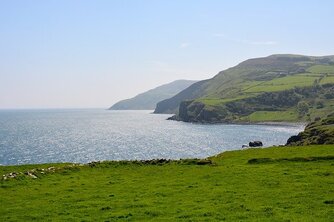 Image by StockSnap from Pixabay Image by StockSnap from Pixabay What's in a name? Musical titles that simply state their intended purpose or form can come across as somewhat lazy and, well, boring. Titles such as "Prelude in E Major," "Postlude in D MInor," and — wait for it—"Offertory" are classic examples heard in a church setting. But what if these seemingly banal titles offer a vital clue to the composition's reason for even being and deepens the listening experience? Well, that's different then! "Opening" from Glassworks (1981) by Philip Glass begins the morning services in a lush inviting cascade of hypnotic polyrhythms. Glass intended the six movement chamber work for a general audience— accessible pop-oriented art music suited for the masses. The Musical Offering is my minimalist arrangement of the communion hymn "Come With Joy" played by the Plymouth Ringers. The joyful treatment of this tune from the Southern Harmony (1835) recalls the message of unity and love in verse 3: "As Christ breaks bread, and bids us share, each proud division ends. The love that made us, makes us one, and strangers now are friends." "Festival Voluntary" (published in 1958) by Flor Peeters is an excursion into the classic English cathedral tradition. A prominent Belgian organ pedagogue and recitalist, his compositions often employed characteristics of Renaissance music and contemporary polytonality and polyrhythms. This more straightforward work was dedicated to his close friend Reverend Father Canon Titus Timmerman. At 6:00 p.m., cantor Lucas Jackson joins us along with minimalist piano offerings by composers Philip Glass and Michael Nyman.
0 Comments
 Image by Sven Lachmann from Pixabay Image by Sven Lachmann from Pixabay Off into the Baroque on a path less traveled by. A pastorale is a music form intended to convey nature—the pastures of shepherds and their flock. Though often associated with the Christmas season, we hear at the Prelude a sectional work in this style by Italian composer Domenico Zipoli (1688-1726.) Zipoli interestingly became a Jesuit missionary who spent his final years teaching and composing among the Guarani people in Peru. The Musical Offering brings us to the French Baroque with the dance-like "Gavotte" by Jean-Philippe Rameau (1683-1764). A leading music theorist and composer for opera and harpsichord, this fanciful work for violin and keyboard is an excerpt from his 1745 opera-ballet, "Le Temple de la Gloire" (The Temple of Glory). Violinist Harmony Tucker joins. Sending us out into the world is a Postlude technically not from the 18th century but composed in that idiom with faithful accuracy. Based on the German Easter hymn "Erschienen ist der herrlich Tag" (Appeared is the Splendid Day), this 19th century setting by Austrian composer Heinrich von Herzogenberg (1843-1900) employs common Baroque compositional techniques such as canon, imitation, and the use of the cantus firmus (i.e. the hymn tune) in the pedal. As a devotee and champion of J.S. Bach's music, the Master's influence is easily felt throughout this chorale prelude. At the 6:00 p.m. service, bassist Peter Strening and cantor Blair Carpenter lead songs of the Good Shepherd and offer sounds of jazz and an inadvertent song of the Easter season by the band Coldplay.  Image by fsHH from Pixabay Image by fsHH from Pixabay Spring and Eastertide are intrinsically linked in my mind, even if Easter Sunday comes early in a particular liturgical year. They are seasons for new beginnings, growth, transformation—resurrection! So back to the lush greenery of Ireland we go for musical inspiration. It's been said a fiddle is nothing more than a violin with a good Irish beer spilled on it. This week, that definition will do! Fiddler Abigail Morgan offers "Sí Beag, Sí Mór" (Small Fairy Mound, Big Fairy Mound) attributed to 17th century harp composer Turlough O'Carolan. The title refers to two small hills thought to be burial mounds in the northern region of Ireland. The traditional Irish tune "Be Thou a Smooth Way" is given a reading with the services ending in a collection of traditional jigs and reels, mostly. |
Details
|

 RSS Feed
RSS Feed